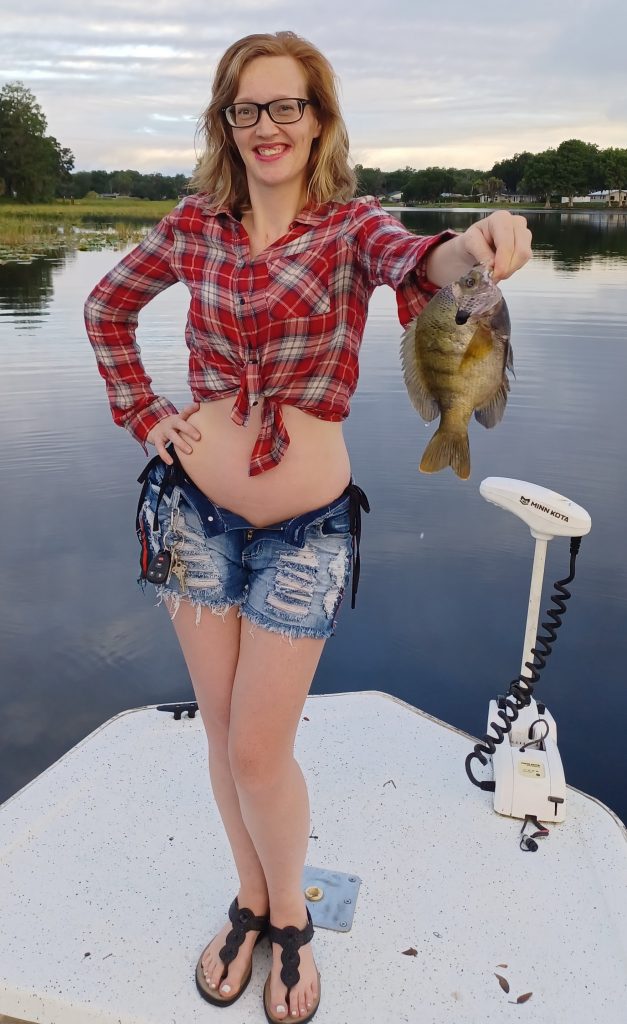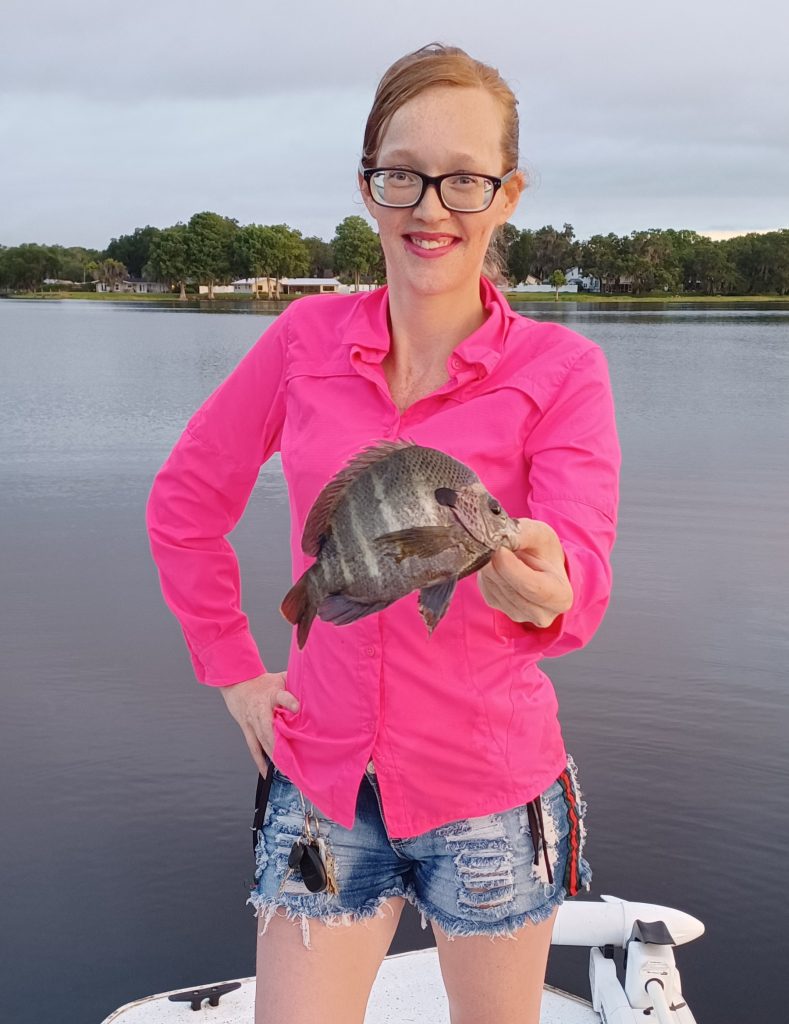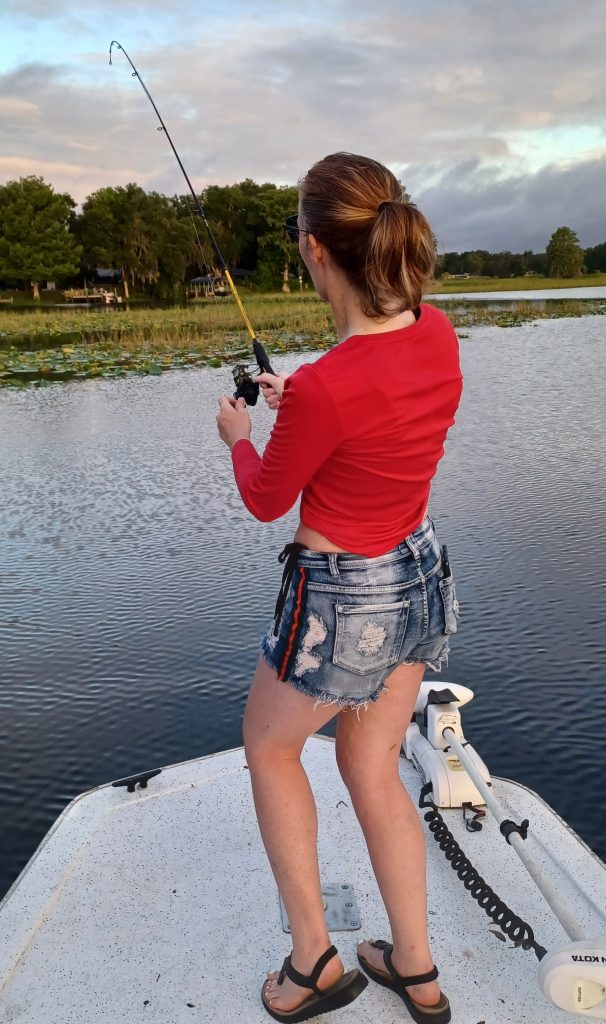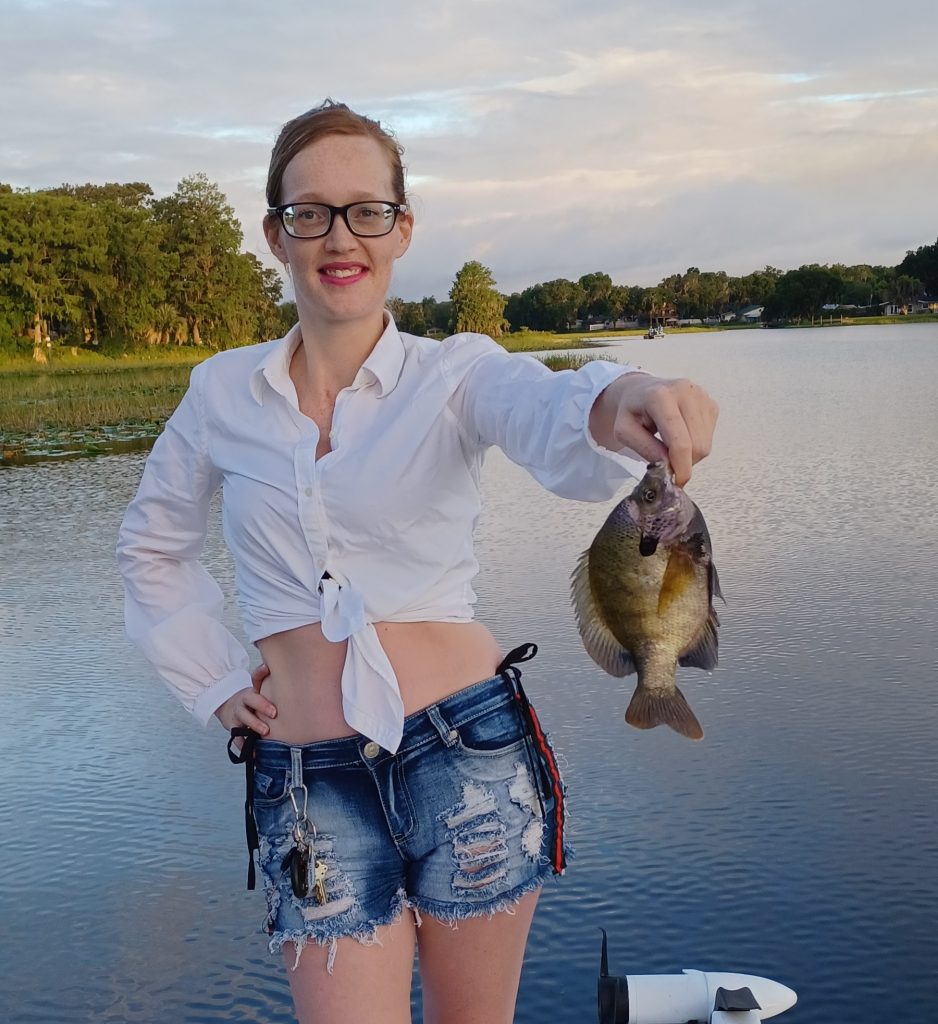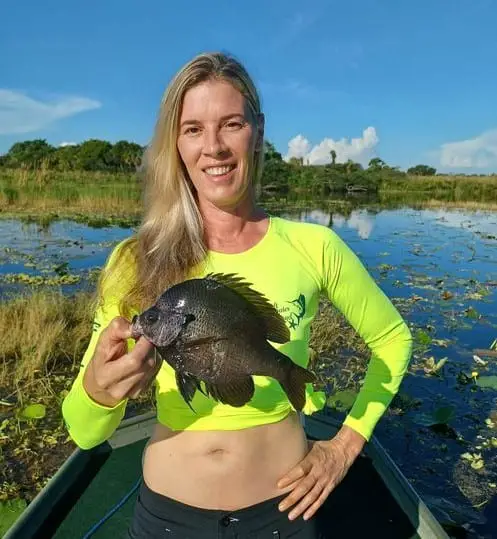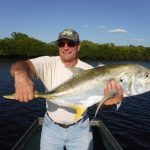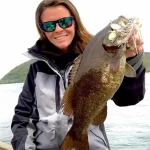Bluegill Fishing – Tips, Techniques, and Tackle
This post will thoroughly cover bluegill fishing. Bluegill and other panfish are arguably the most popular freshwater game fish species. They are widely distributed, abundant, aggressive, and very good to eat. These are all factors that add to their popularity.
Bluegill, Lepomis macrochirus, are a member of the sunfish family Centrarchidae. They are a warm water species that is native to North America. Bluegill are omnivores and feed mostly on aquatic insects, crustaceans, and bait fish. They prefer shallow water with cover. Bluegill are found in just about every warm water body East of the Rockies, though they are found on the West Coast as well.
Bluegill fishing – tackle
One of the most appealing aspects of bluegill fishing is the simplicity. This is a very relaxing endeavor! Anglers do not need expensive rods and reels or high-powered bass boats in order to be successful. In fact, many anglers still do well using a simple cane pole and a piece of line with a bobber and a hook.
Bluegill fishing rods and reels
For most anglers bluegill fishing, and ultralight spinning outfit is the best choice. A 5 foot to 6 foot ultralight rod with a 1000 series reel is an excellent all round combination. It will allow anglers to cast light live baits and artificial lures as well as giving a small bluegill the chance to give a decent account of itself.
Click to shop Amazon for ultra light spinning outfits
Bluegill are often the first fish a young angler catches in his or her life. There is a good chance that it was done so using a spin cast, or push button reel. The venerable Zebco 202 is a prime example of this. These outfits are fine for anglers who prefer to use them when fishing for bluegill. However, they do have their limitations as far as retrieve speed, drag, and line capacity are concerned. They are easy to use and will do fine in most bluegill fishing applications.
Click to shop Amazon for Zebco ultra light spincast outfits
“Fishing Lido Key is a participant in the Amazon Associates Program, an affiliate advertising program designed to provide a means for sites to earn advertising fees by advertising and linking to Amazon. As an Amazon Associate I earn from qualifying purchases. ”
Fishing line options
Anglers have several choices when it comes to fishing line. These are braided line, monofilament line, and fluorocarbon line. Braided line is expensive but last a long time. It also is very thin in diameter and cast a long way while being very abrasion resistant. Monofilament line is the least expensive.
Fluorocarbon line is similar to monofilament but is nearly invisible in the water, though it is more expensive. It has become the choice of anglers fishing with ultralight tackle of late. However, monofilament line will do just fine and has proven itself over the decades. 4 lb test is a good all round line strength.
Click to shop Amazon for fishing line
Fishing for bluegill
Like any other fish, it is important to understand bluegill habits in order to be successful. Bluegill are members of the sunfish family, and are really cousins to the largemouth bass. There habits are quite similar in many ways. Bluegill prefers shallow areas with some type of cover. They can be found around any type of aquatic vegetation as well as man made structures, especially docks.
Bluegill love wood! A fallen tree or pile of submerged brush will almost certainly hold some bluegill. This is especially true in an otherwise wood free bank or stretch of shoreline. Docks fall into this category as well.
During the extreme hot and cold periods of the year, bluegill, especially large ones, will move out into deeper water to seek refuge from the high or low water temperature. There will almost always be smaller bluegill to be had in the shallow water. As it warms up and spring, bluegill will move sure word to feed and prepare to spawn.
Spawning cycle of bluegill
Many anglers target bluegill during this time of year, late spring and early summer, when fish moved to the beds. These fish are generally larger and aggressive, which makes them easy to catch. In fairly clear water, these beds are easy to spot. They look like little saucers of around a foot diameter. They are created by the mail bluegill which uses it’s tail to clear out or build a nest.
Bluegill tend to bed in big bunches. Once a productive area is located, an angler can catch a lot of fish in a short period of time. After the female deposits for eggs, the mail guards the nest and will aggressively attack any interloper. While bluegill limits are usually generous, it is important to not take too many of the larger males.
In fact, many bluegill anglers now let the larger fish go and keep the smaller 6 inch to 18 inch fish for a meal. This type of responsible angling will result in a quality fishery for many years to come!
Post spawn bluegill migrations
After the spawn, the schools of larger bluegill will often move offshore to deeper water. This can be a challenging time to catch them. However for anglers who put in the time and locate school of these big fish, the action can be fast and furious. Bluegill will stage in the same types of spots as most other fish; channel edges, sloping points, artificial reefs, submerged islands, and bridges in deeper water are all prime spots.
As it starts to cool off, bluegill will move towards the shoreline once again. However, in this instance it will be to feed and put on some weight for the upcoming winter. Bluegill will usually be a bit more scattered this time of year and not schooled up as a are in the spring. This makes using artificial lures an excellent choice as it allows anglers to cover a lot of water.
Bluegill do not stop eating when the water freezes. Ice fishing for bluegill is very popular and quite productive. The same winter patterns produce whether the water is frozen or not. The best fishing will usually be found in 10 feet of water to 25 feet of water over cover and structure breaks.
Bluegill fishing tips
-
Keep moving! Too many anglers make the mistake of staying in one spot to long. Just because a spot produced yesterday, doesn’t mean it necessarily well today. As conditions such as wind, current, and water temperature change, bluegill will change locations, just as all game fish will. Once a productive area is located, then it is time to slow down and fish that area thoroughly.
-
Change it up! This applies to anglers casting artificial lures as well is fishing with live bait. Just as with spots, the most productive bait or lure will change day today. While every angler has his or her favorite lure or bait, when it isn’t producing it is time to change.
-
Vary the color and retrieve when fishing was artificial lures. Generally speaking bluegill prefer a very slow retrieve, there are days when this is not the case. Successful anglers will keep several rods rigged with a variety of offerings and constantly change the lure and retrieve until a productive pattern emerges.
-
Pay attention to conditions! Fishing conditions are constantly changing and successful anglers adapt with these changes. Bright sunlight will push fish undercover while bluegill will roam about more on cloudy days. Extremes and water temperature will result in bluegill being less active. Current and water levels will position fish in different spots.
-
Keeping bluegill to eat! Part of the enjoyment of bluegill fishing are the prospects of a fish fry afterwards. There is nothing wrong with this! In fact, some bodies of water are actually improved by taking fish out as there can be too many bluegill for the available forage. However, as difficult as it might be, it can be best to let the really large bluegill go back and keep to medium-size fish to eat.
Bluegill fishing Techniques
There are several techniques which have proven to be quite effective when bluegill fishing. Anglers can keep it simple and just use a cane pole and worm or cricket. Most prefer to cast live were artificial baits using spinning or spin casting tackle. Fly fishing is also extremely productive.
Bluegill fishing with live bait
Live bait is extremely effective when bluegill fishing. Bluegill have quite the varied diet and have a fairly large mouth proportionate to their body size. These two habits are part of the reason that bluegill are such a prolific species. They really will eat just about anything that they can get in their mouth.
Live bait fishing for bluegill in shallow water
Many anglers fishing for bluegill in shallow water use a simple rig that consists of a float and a hook. The float accomplishes several things. It provides wait for casting, suspends the bait at the desired depth, and indicates to the angler when a strike occurs. There are several types of floats that an angler can use, with round floats and quill floats being the most popular.
Anglers should keep the hook size fairly small when fishing for bluegill with live bait. A #8 live bait hook is an excellent all round choice. Anglers can drop down to a #10 hook if bluegill are particularly finicky. Conversely, when bluegill are running particularly large, a #6 hook might be in order. A split shot can be added near the hook if needed to get the bait down in the water column.
Live bait fishing for bluegill in deep water
Anglers bluegill fishing in deeper water have a couple different choices. A simple rig of a hook and a split shot or two will get the bait down deep enough in most instances. Anglers can also opt for a drop shot rig which uses a heavier weight with a hook tide in line 12 inches to 18 inches above the weight. This will present the bait just above the bottom where bluegill often feed.
Floats can be used deeper water as well. These are what are known as “slip boppers”. The running line passes through a hole in the float, followed by a small swivel to stop the float. A short leader is used between the swivel and the hook. A thread stop of some sort is placed on the line which determines the depth that the bait will be presented. This ingenious system allows anglers to cast easily while still using a float and deep water.
Best live baits for bluegill fishing
There are several options that anglers bluegill fishing have when using live bait. These include, but are not limited to, worms, crickets, mealworms and grubs, grass shrimp, crayfish, minnows, and grasshoppers.
Worms and nightcrawlers
Worms and nightcrawlers are perhaps the most popular bluegill fishing baits, and for good reason. They are easy to obtain and keep alive as well as being very effective. Anglers can dig or catch their worms in the dirt where they live or purchase them at stores. Many big-box department stores sell them now in the fishing department. Smaller wigglers and other worms are used whole, while anglers using nightcrawlers usually pinch off a piece about an inch long.
Crickets
Many seasoned anglers believe that crickets catch larger bluegill. Most bait shops that sell crickets are using the gray cricket. It is an excellent size and relatively easy to keep alive. However, using crickets is a bit more involved than worms. Crickets are usually hooked under the collar right behind the head and are normally fished under a float. They are a terrific bluegill fishing bait, particularly in the summer.
Mealworms and grubs
Mealworms and grubs are fantastic bluegill fishing baits! While many anglers think of them as ice fishing baits, they produce all year long. Mealworms are easy to obtain and can even be purchased online. As long as a are not exposed to extreme hot or cold, mealworms will live a long time. They are best presented on a very small hook. Anglers even tip artificial lures with mealworms at times.
Grass shrimp
Grass shrimp are another fantastic live bait for catching bluegill. Some bait shops sell them, though serious anglers will catch their own using a fine-mesh net in the shoreline vegetation. A very thin, fine wire hooks should be used on these delicate baits. They work extremely well all year long when fished under a float near any type of vegetation.
Crayfish
Most anglers associate crayfish when fishing for bass or other larger species. However, tiny 1 inch crayfish are fantastic live baits for trophy bluegill. Anglers using crayfish will usually not catch as many fish, but they will be larger. They are difficult to obtain as anglers must catch their own, but many consider it worth the effort.
Minnows
Like crayfish, anglers consider live minnows a bait for species other than bluegill. However, tiny 1 inch minnows can be a very effective bait. In fact, many artificial lures designed for bluegill fishing mimic a wounded bait fish. Also as with crayfish, minnows will produce fewer bluegill, but they will almost always be larger specimens. Anglers must use some type of aeration system to keep minnows alive in a bucket or well for any length of time.
Grasshoppers
Grasshoppers are primarily a summertime bait. They are very effective, though in most cases anglers will have to catch their own. It is best to get them in fields in the morning when the grass is still damp and they are easier to catch. Grasshoppers are often fished on the surface and produce some exciting strikes. They are easy to keep alive, though special cages are sold so that anglers can get one grasshopper out without the rest escaping.
Fishing for bluegill with artificial lures
While many anglers use live bait when bluegill fishing, just as many prefer to do so using artificial lures. There are several benefits to this. Convenience is one major factor, there is no need to purchase, acquire, or keep baits alive. Artificial lures allow anglers bluegill fishing to cover a lot of water in search of fish. Lures will also elicit strikes from bluegill when they are not hungry as they will hit the lore for other reasons. Finally, lures are just fun to fish!
Best bluegill fishing lures
There are quite a few artificial lures that are productive for bluegill fishing. Most of them are just diminutive versions of baits that produce largemouth bass and other species. These include jigs, spinners, spoons, spinner baits, and plugs. In an effort to simplify the selection, Capt. Jim will list his favorite bluegill fishing lures with one from each category.
Read more about the best bluegill fishing lures
Johnson Beetlespin
The Johnson Beetlespin is Capt. Jim’s favorite bluegill fishing lure. In fact, it will catch just about every freshwater species. This bait is a small version of a spinner bait, which really is a combination of a jig in a spinner and one lure. It is an easy lure to use and a great choice for anglers just starting out fishing with artificial baits.
The Beetlespin has a lot of built in action. The most effective retrieve when fishing for bluegill is a slow, steady one. The bait is cast out, allowed to sink a few seconds then retrieved back in. It is a good idea to give the bait a twitch at the beginning to get the blade spinning. Spinner baits are relatively weedless and this one will bounce over limbs and other underwater obstructions. It works well when cast around any type of structure and is also effective when slowly trolled. Darker colors such as black and green produce very well.
Miser Twister Teeny curly tail grub
Tiny jigs are very effective bluegill fishing lures. Capt. Jim’s favorite is the Mister Twister Teeny curly tail grub. It is fished on a 1/32 ounce or 1/16 ounce jig head. The curly tail puts out tremendous action both when retrieved and when allowed to fall. The jig can be cast out towards shoreline structure and vegetation as well as fished vertically when bluegill are schooled up in deeper water. It is an excellent ice fishing lure as well. Chartreuse and white are two top colors.
Worden’s Rooster tail
Spinners are very simple freshwater lures that have been around a long time. They consist of a shaft with a body, a blade that rotates around the body, and a hook at the tail. The hook is often dressed with some type of natural or synthetic hair. Spinners put out a lot a flash and vibration. They work best with a slow, steady retrieve.
Capt. Jim’s favorite spinner is the Worden’s Rooster tail spinner. It is very light, which makes it an excellent choice in small streams as well as ponds and lakes. They are available in a wide variety of color patterns. Brightly colored bodies with a gold blade in the 1/16 ounce size are excellent when fishing for bluegill. The slower the retrieve the better, as long as the blade is rotating.
Kastmaster spoon
Tiny spoons will certainly full bluegill as well. Capt. Jim’s favorite bluegill fishing spoon is the Acme Kastmaster spoon. This is a slender, but dense bait that cast a long way and has a very tight wiggle. It is best used in open water as the trouble hook will snag on vegetation. It is an excellent choice for casting, trolling, vertical fishing, and ice fishing.
Rapala Original Floating Minnow
Small plugs will catch some of the largest specimens for anglers fishing for bluegill. These are diminutive versions of what bass anglers would call jerk baits. Most float at rest and then dive down upon retrieve. The Rapala Original Floating Minnow in the smallest size is a very good bluegill fishing lure. It works best in shallow water and can be cast out and retrieved as well as trolled.
Fly fishing for bluegill
Fly fishing for bluegill is very popular as well. Unlike fishing for freshwater trout and some other species, fly fishing for bluegill is relatively uncomplicated. Anglers do not need expensive equipment, a ton of different flies, or the ability to cast a long way in order to have success. Fortunately, bluegill are not usually very fussy when it comes to taking a fly.
As with spinning tackle, anglers fly fishing for bluegill will want to keep the tackle light. A 3wt or 4wt outfit with a floating line works well. Most fly fishing for bluegill will be done in quite shallow water. An 8 foot to 9 foot tapered leader of about 4 pound test completes the rig.
Fly selection is fairly uncomplicated as well. Bluegill will take just about any small, buggy looking fly in a dark color. Woolly Buggers are an excellent pattern. Bluegill will certainly come to the surface to take a fly in many anglers take advantage of this by using poppers. Finally, tiny streamers that imitate bait fish will produce as well.
Read more about fly fishing for bluegill
In conclusion, this article on bluegill fishing will help anglers understand the habits and tackle requirements for catching these hard fighting little freshwater fish!
